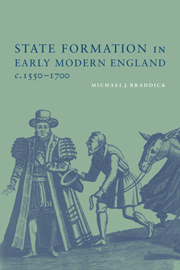Book contents
- Frontmatter
- Contents
- Acknowledgements
- Abbreviations and conventions
- GENERAL INTRODUCTION
- PART I STATE FORMATION IN EARLY MODERN ENGLAND
- PART II THE PATRIARCHAL STATE
- PART III THE FISCAL-MILITARY STATE
- PART IV THE CONFESSIONAL STATE
- PART V THE DYNASTIC STATE
- CONCLUSION: actions without design, patterns without blueprints
- Index
CONCLUSION: actions without design, patterns without blueprints
Published online by Cambridge University Press: 04 December 2009
- Frontmatter
- Contents
- Acknowledgements
- Abbreviations and conventions
- GENERAL INTRODUCTION
- PART I STATE FORMATION IN EARLY MODERN ENGLAND
- PART II THE PATRIARCHAL STATE
- PART III THE FISCAL-MILITARY STATE
- PART IV THE CONFESSIONAL STATE
- PART V THE DYNASTIC STATE
- CONCLUSION: actions without design, patterns without blueprints
- Index
Summary
Mankind, in following the present sense of their minds, in striving to remove inconveniences, or to gain apparent and contiguous advantages, arrive at ends which even their imaginations could not anticipate … and nations stumble upon establishments, which are indeed the result of human action, but not the execution of any human design
[In order to] account for structural change it has to be shown how social groups as collective actors exercise pressure on existing constraints and, through acting upon interests of their own and by mobilising distinctive resources, make use of the enabling aspects of the environment.
This has been a study of state formation in early modern England. The state consisted of a network of offices exercising political power coordinated under the Tudor and Stuart crown. It has not been defined in terms of particular institutional forms, or functions, but in terms of the kind of power that these offices embodied. No single will or interest lay behind the use that was made of these offices. Instead, agency was given to the state by activists, both officeholders and those who could influence them. These people responded to the problems and opportunities that they perceived around them by designing and implementing political innovations. However, although there was no architect or overall blueprint – this was not state building – it is still possible to discern and explain patterns in the outcomes of these innovations. There were consistent patterns in the way that political power was embodied in the villages and wards of the early modern English-speaking world.
Information
- Type
- Chapter
- Information
- State Formation in Early Modern England, c.1550–1700 , pp. 427 - 437Publisher: Cambridge University PressPrint publication year: 2000
